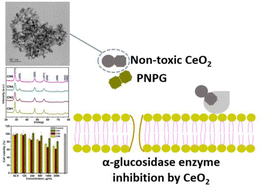Effects of NO3−, Cl−, and CH3COO− anions and diethylene glycol on the morphological, structural, antidiabetic, and cell viability properties of CeO2 nanoparticles†
Abstract
Cerium oxide (CeO2) nanoparticles (NPs) were synthesized using a modified conventional polyol method. The ratio of diethylene glycol (DEG) and water in the synthesis was varied, and three different cerium precursor salts (Ce(NO3)3, CeCl3, and Ce(CH3COO)3) were used. The structure, size, and morphology of the synthesized CeO2 NPs were studied. An average crystallite size of 13 to 33 nm was obtained from the XRD analysis. Spherical and elongated morphologies of the synthesized CeO2 NPs were acquired. Average particle sizes in the range of 16–36 nm were obtained by varying different ratios of DEG and water. The presence of DEG molecules on the surface of CeO2 NPs was confirmed using FTIR. Synthesized CeO2 NPs were used to study the antidiabetic and cell viability (cell cytotoxicity) properties. Antidiabetic studies were carried out using α-glucosidase enzymes inhibition activity. CeO2 synthesized using Ce(NO3)3 and CeCl3 precursors showed approximately 40.0% α-glucosidase enzyme inhibition activity, while CeO2 synthesized using Ce(CH3COO)3 showed the lowest α-glucosidase enzyme inhibition activity. Cell viability properties of CeO2 NPs were investigated using an in vitro cytotoxicity test. CeO2 NPs prepared using Ce(NO3)3 and CeCl3 were non-toxic at lower concentrations, while CeO2 NPs prepared using Ce(CH3COO)3 were non-toxic at all concentrations. Therefore, polyol-mediated synthesized CeO2 NPs showed quite good α-glucosidase inhibition activity and biocompatibility.



 Please wait while we load your content...
Please wait while we load your content...